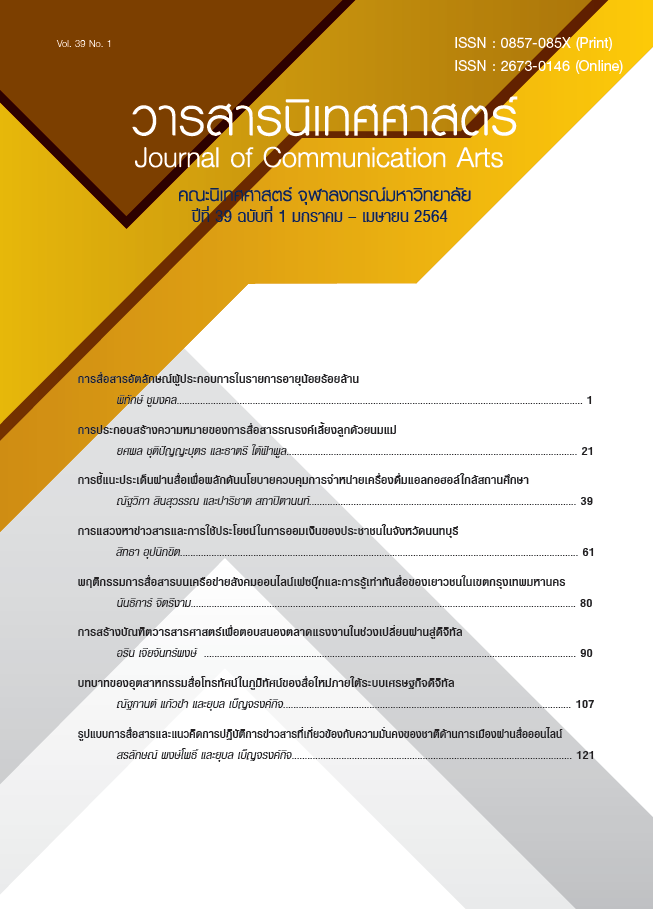Media Advocacy for Advancing the Policy of Restriction on Banning Sales of Alcohol Beverages Near Educational Institutions
Main Article Content
Abstract
The research of media advocacy for advancing the policy of restriction on banning sales of alcohol beverages near educational institutions aimed to (1) study the development of media advocacy (2) study the media advocacy process, and (3) study the factors that lead to the success of the media advocacy. This research was conducted by qualitative research methodology. Document analysis and in-depth interview with key informants who involved in media advocacy process were used to complete this research. The results indicated that the media advocacy started after the Ministry of Public Health issued the Alcoholic Beverage Control Act in 2008. However, in practice, the policy cannot be effectively enforced because it did not specify the acceptable distance between the alcohol vendors and educational institutions. This led to the awareness of the alcohol control organizations continuously implementing media advocacy policy for more than 7 years until a tangible change was made when the National Council for Peace and Order issued the 22/2558 regulating the sale of alcohol beverages near the educational institutions. The results also showed that the media advocacy process consisted of the following 6 stages; (1) Building the advocacy team, (2) Analyzing the situation, the policymakers and stakeholders (3) Setting the goal and identifying the target group, (4) Identifying the message and speaker, (5) Communicating the integrated media, and (6) Monitoring the process and the policy. Moreover, the results showed the factors contributing to the success in advancing policy were (1) the competence of the media advocacy team to monitor the issues, (2) the readiness of the information, (3) the co-operation of the mass media in reporting the news, and (4) the supporting of situation and public.
Article Details
References
จารึก ไชยรักษ์. (2552). การชี้แนะสาธารณะเพื่อผลักดันมาตรการห้ามตั้งแสดงบุหรี่ ณ จุดขายในประเทศไทย. วิทยานิพนธ์วิทยาศาสตรมหาบัณฑิต (สาธารณสุขศาสตร์) บัณฑิตวิทยาลัย มหาวิทยาลัยมหิดล.
จุติพร ปริญโญกุล. (2554). กลยุทธ์การบริหารประเด็นเพื่อผลักดันพระราชบัญญัติควบคุมเครื่องดื่มแอลกอฮอล์ พ.ศ.2551. วิทยานิพนธ์นิเทศศาสตรมหาบัณฑิต คณะนิเทศศาสตร์ จุฬาลงกรณ์มหาวิทยาลัย.
ชวาลา ภวภูตานนท์ ณ มหาสารคาม. (2557). กระบวนการผลักดันและขับเคลื่อน “ร่างพระราชบัญญัติ ควบคุมการบริโภคยาสูบ พ.ศ.....”. (เอกสารอัดสำเนา)
ณัฐวิภา สินสุวรรณและปาริชาต สถาปิตานนท์. (2550). กระบวนการเรียกร้องผ่านสื่อของกลุ่มสนับสนุนการไม่สูบบุหรี่ในการขับเคลื่อนกฎหมายควบคุมการบริโภคยาสูบในประเทศไทย. วารสารนิเทศศาสตร์, 25(1), 66-81.
นิธิตา สิริพงศ์ทักษิณ. (2554). การเมืองในนโยบายสื่อสาธารณะขององค์การกระจายเสียงและแพร่ภาพสาธารณะแห่งประเทศไทย. วิทยานิพนธ์รัฐศาสตรดุษฎีบัณฑิต คณะรัฐศาสตร์ จุฬาลงกรณ์มหาวิทยาลัย.
ประเทือง ม่วงอ่อน. (2547). การเปลี่ยนแปลงนโยบายสุรา: ศึกษากรณีการผลักดันนโยบายโดยกลุ่มเครือข่ายเหล้าพื้นบ้านแห่งประเทศไทย. วิทยานิพนธ์รัฐศาสตรมหาบัณฑิต คณะรัฐศาสตร์ จุฬาลงกรณ์มหาวิทยาลัย.
ปาริชาต สถาปิตานนท์. (2551). การสื่อสารประเด็นสาธารณะและการเปลี่ยนแปลงในสังคมไทย. กรุงเทพฯ: สำนักพิมพ์แห่งจุฬาลงกรณ์มหาวิทยาลัย.
วดี ภิญโญทรัพย์ และธาตรี ใต้ฟ้าพูล. (2557). กลยุทธ์การสื่อสารทางสังคมเพื่อการคัดค้านการขนถ่ายถ่านหินที่บางปะกงและศรีราชา. วารสารการประชาสัมพันธ์และการโฆษณา, 7(1), 91-104.
ศูนย์วิจัยปัญหาสุรา (ม.ป.ป.). ทำไมต้องควบคุมร้านขายเครื่องดื่มแอลกอฮอล์รอบสถานศึกษา. (เอกสารอัดสำเนา)
Arnott, D., Dockrell, M., Sandford, A., & Willmore, I. (2007). Comprehensive smoke-free legislation in England: how advocacy won the day. Tobacco control, 16(6), 423–428, doi:10.1136/tc.2007.020255.
Babor, T. F., Robaina, K., & Noel, J. (2018). The role of the alcohol industry in policy interventions for alcohol-impaired driving. In: Negussie, Y., Geller, A., & Teutsch, S. M. (Eds), Getting to zero alcohol-impaired driving fatalities: a comprehensive approach to a persistent problem (pp.C1-37). Washington (DC): National Academies Press.
Berteletti, F., King, J., Burch, J., & Friedlaender, A. T. (2017). Campaign for a revised Tobacco Products Directive in the European Union: lessons learnt. Tobacco Control, 26(4), 464-467, doi:10.1136/tobaccocontrol-2016-053078.
Bowen, G. (2009). Document analysis as a qualitative research method. Qualitative Research Journal, 9(2), 27-40, doi:10.3316/QRJ0902027.
Chapman, S., & Lupton, D. (1994). The fight for public health: principle & practice of media advocacy. London: BMJ Publishing Group.
Crosbie, E., Sebrié, E. M., & Glantz, S. A. (2011). Strong advocacy led to successful implementation of smokefree Mexico City. Tobacco Control, 20(1), 64-72, doi:10.1136/tc.2010.037010.
Cross, R., Davis, S., & O’Neil, I. (2017). Health Communication: theoretical and critical perspectives. Cambridge: Polity Press.
DeJong, W. (1996). MADD Massachusetts Versus Senator Burke: a media advocacy case study. Health Education Quarterly, 23(3), 318-329.
Holder, H. D., & Treno, A. J. (1997). Media advocacy in community prevention: news as a means to advance policy change. Addiction, 92(6s1), 189-199, doi:10.1046/j.1360-0443.92.6s1.3.x.
Jernigan, D. H., & Wright, P. A. (1996). Media advocacy: lessons from community experiences. Journal of Public Health Policy, 17(3), 306-330.
Jiang, N., & Ling, P. (2013). Alliance between tobacco and alcohol industries to shape public policy. Addiction, 108(5), 852–864, doi.org/10.1111/add.12134.
Kapin, A., & Ward, A. S. (2013). Social change anytime everywhere: how to implement online multichannel strategies to spark advocacy, raise money and engage your community. San Francisco: Jossey-Bass.
Lewis, B., & Lewis, J. (2015). Health communication: a media and cultural studies approach. London: Palgrave.
Mattson, M., & Lam, C. (2016). Health advocacy: a communication approach. New York: Peter Lang.
Naderifar, M., Goli, H., & Ghaljaie, F. (2017). Snowball Sampling: a purposeful method of sampling in qualitative research. Strides Dev Med Educ, 14(3), e67670, doi: 10.5812/sdme.67670.
Parvanta, C. F., Nelson, D. E., & Harner, R. N. (2018). Public health communication: critical tools and strategies. Burlington, MA: Jones & Bartlett Learning.
UCLA Center for Health Policy Research. (2002). Media advocacy to advance public health policy. Los Angeles, CA: Health Data Program.
Vathesatogkit, P., & Charoenca, N. (2011). Tobacco control: lessons learnt in Thailand. Indian Journal of Public Health, 55(3), 228–233.
Wallack, L. (1994). Media advocacy: A strategy for empowering people and communities. Journal of Public Health, 15(4), 420-436.
Wallack, L., & Dorfman, L. (2001). Putting policy into health communication. In: Rice, R. E., & Atkin, C. K. (Eds), Public communication campaigns (pp.389-401). Thousand Oaks, California: Sage Publication.
Wallack, L., & Dorfman, L. (1996). Media advocacy: a strategy for advancing policy and promoting health. Health Education Quarterly, 23(3), 293-317.
Wallack, L., Dorfman, L., Jernigan, D., & Themba, M. (1993). Media advocacy and public health: power for prevention. Newbury Park: Sage.
Wise, M. (2001). The role of advocacy in promoting health. Promotion & Education, 8(2), 69-74, doi:10.1177/102538230100800204.
World Health Organization. (2008). Tobacco industry interference with tobacco control. Geneva: WHO Press.


